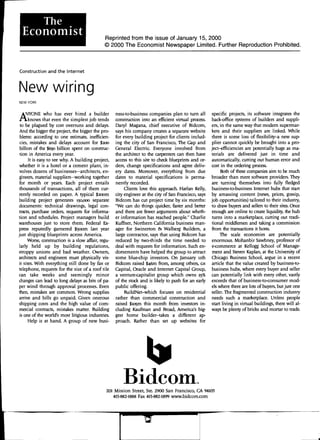Bidcom Economist
Construction projects are plagued by inefficiencies, mistakes, and delays that account for $200 billion annually in the US. New business-to-business companies are creating websites for individual building projects that allow all involved parties to access blueprints, orders, and specifications online, permanently recording all information to reduce mistakes and delays. Companies like Bidcom and BuildNet are also developing industry-wide marketplaces that integrate the systems of builders and suppliers to further streamline the ordering process, reduce human error, and cut costs for the fragmented construction industry. These online hubs aim to become fully-fledged marketplaces that facilitate transactions between all buyers and sellers in the industry.

Recommended
Recommended
More Related Content
What's hot
What's hot (10)
Similar to Bidcom Economist
Similar to Bidcom Economist (20)
Bidcom Economist
- 1. The Economist Reprinted from the issue of January 15, 2000 © 2000 The Economist Newspaper Limited. Further Reproduction Prohibited. Construction and the Internet New wiring NEW YORK ANYONE who has ever hired a builder ./".knows that even the simplest job tends to be plagued by cost overruns and delays. And the bigger the project, the bigger the pro- blems: according to one estimate, inefficien- cies, mistakes and delays account for $200 billion of the $650 billion spent on construc- tion in America every year. It is easy to see why. A building project, whether it is a hotel or a cement plant, in- volves dozens of businesses-architects, en- gineers, material suppliers-working together for month or years. Each project entails thousands of transactions, all of them cur- rently recorded on paper. A typical $200m building project generates 150,000 separate documents: technical drawings, legal con- tracts, purchase orders, requests fur infOrma- tion and schedules. Project managers build warehouses just to store them. Federal Ex- press reputedly garnered $5oom last year just shipping blueprints across America. Worse, construction is a slow affair, regu- larly held up by building regulations, stroppy unions and bad weather. Owners, architects and engineers must physically vis- it sites. With everything still done by fax or telephone, requests for the size of a roof tile can take weeks and seemingly minor changes can lead to long delays as bits of pa- per wind through approval processes. Even then, mistakes are common. Wrong supplies arrive and bills go unpaid. Given onerous shipping costs and the high value of com- mercial contracts, mistakes matter. Building is one of the world's most litigious industries. Help is at hand. A group of new busi- ness-to-business companies plan to turn all construction into an efficient virtual process. Daryl Magana, chief executive of Bidcom, says his company creates a separate website for every building project fur clients includ- ing the city of San Francisco, The Gap and General Electric. Everyone involved from the architect to the carpenters can then have access to this site to check blueprints and or- ders, change specifications and agree deliv- ery dates. Moreover, everything from due dates to material specifications is perma- nently recorded. Clients love this approach. Harlan Kelly, city engineer at the city of San Francisco, says Bidcom has cut project time by six months: 'We can do things quicker, fuster and better and there are fewer arguments about wheth- er information has reached people." Charlie Kuffner, Northern California business man- ager for Swinerton & Walberg Builders, a large contractor, says that using Bidcom has reduced by two-thirds the time needed to deal with requests for information. Such en- dorsements have helped the group to attract some blue-<:hip investors. On January uth Bidcom raised $46m from, among others, GE Capital, Oracle and Internet Capital Group, a venture-<:apitalist group which owns 25% of the stock and is likely to push fur an early public offering. BuildNet-which focuses on residential rather than commercial construction and raised $105m this month from investors in- cluding Kaufman and Broad, America's big- gest home builder-takes a different ap- proach. Rather than set up websites for Bidcom,. specific projects, its software integrates the back-office systems of builders and suppli- ers, in the same way that modern supermar- kets and their suppliers are linked. While there is some loss of flexibility-a new sup- plier cannot quickly be brought into a pro- ject-efficiencies are potentially huge as ma- terials are delivered just in time and automatically, cutting out human error and cost in the ordering process. Both of these companies aim to be much broader than mere software providers. They are turning themselves into fully fledged business-to-business Internet hubs that start by amassing content (news, prices, gossip, job opportunities) tailored to their industry, to draw buyers and sellers to their sites. Once enough are online to create liquidity, the hub turns into a marketplace, cutting out tradi- tional middlemen and taking a commission from the transactions it hosts. The scale economies are potentially enormous. Mohanbir Sawhney, professor of e-<:ommerce at Kellogg School of Manage- ment and Steven Kaplan, at the University of Chicago Business School, argue in a recent article that the value created by business-to- business hubs, where every buyer and seller can potentially link with every other, vastly exceeds that of business-ta-<:onsumer mod- els where there are lots of buyers, but just one seller. The fragmented construction industry needs such a marketplace. Unless people start living in virtual buildings, there will al- ways be plenty ofbricks and mortar to trade. 201 Mission Street, Ste. 2900 San Francisco, CA 94105 415-882-1888 Fax 415-882-1899 www.bidcom.com
